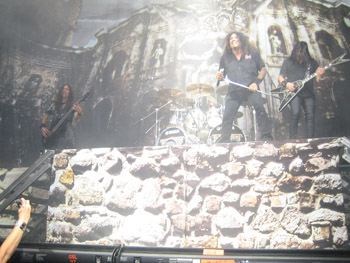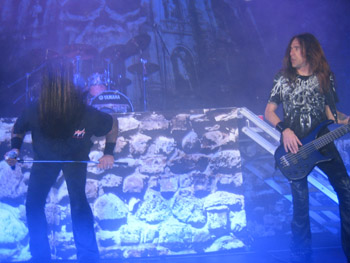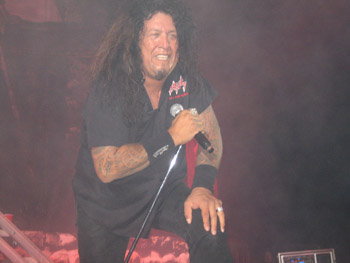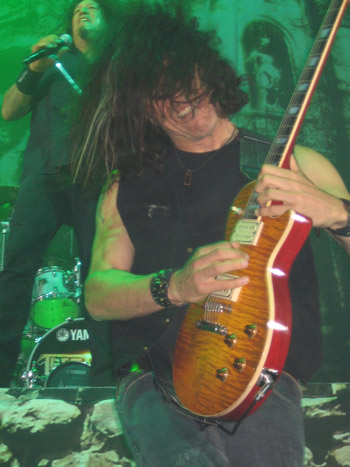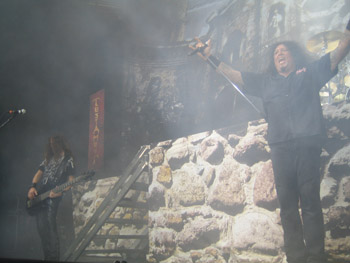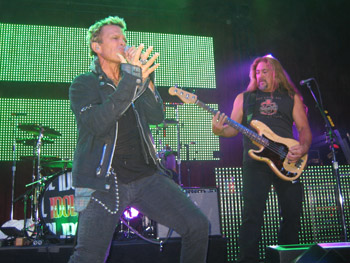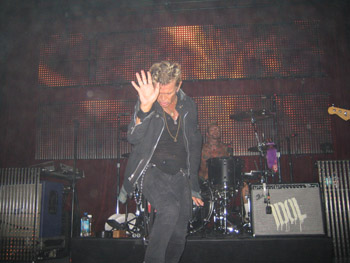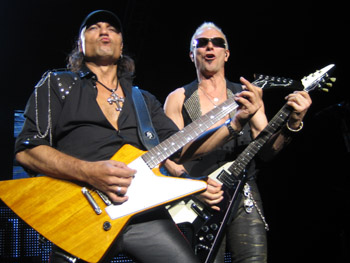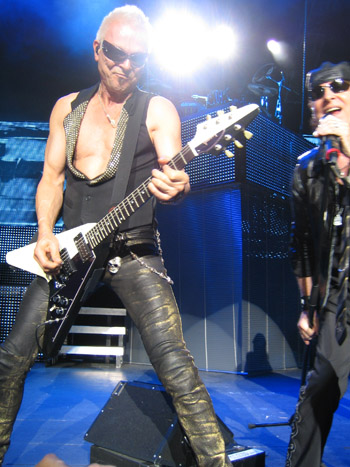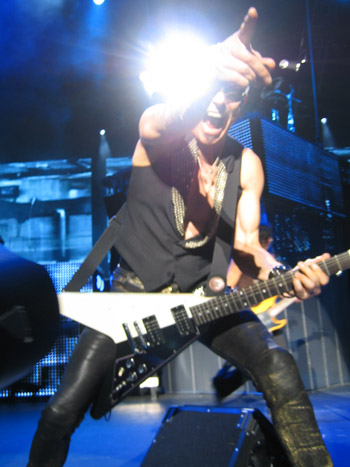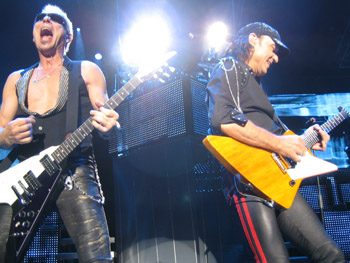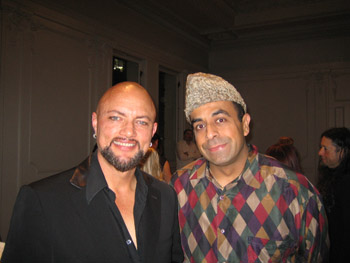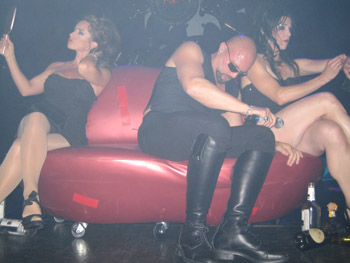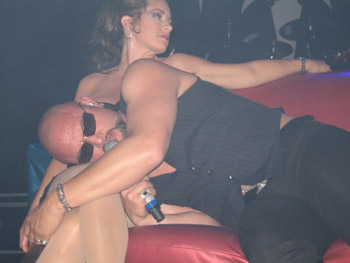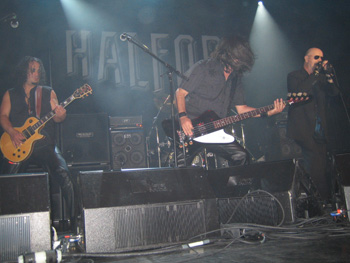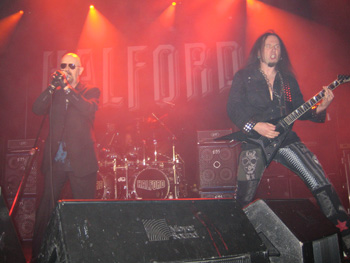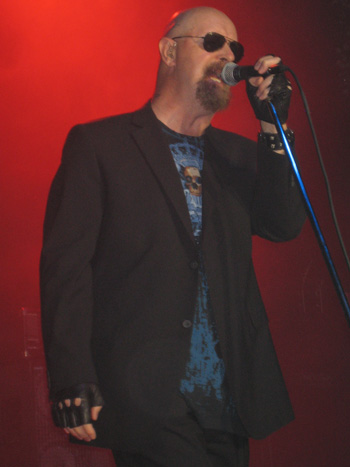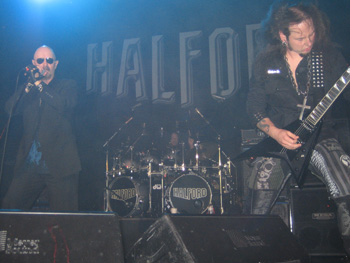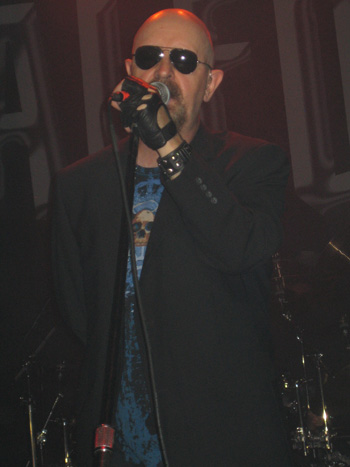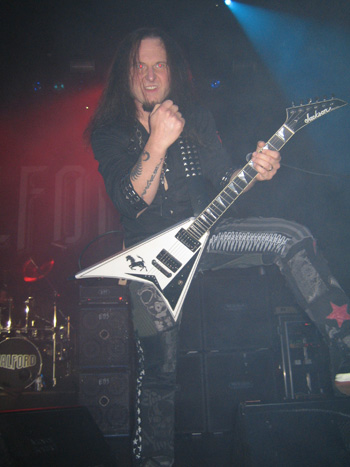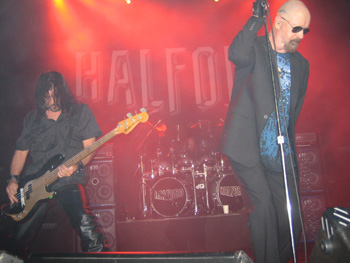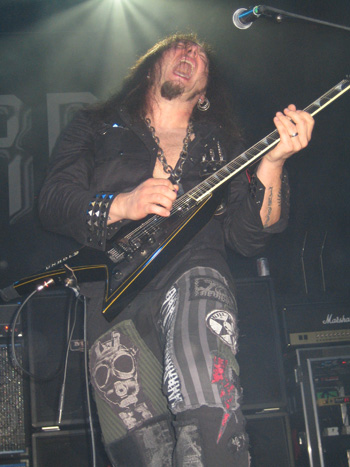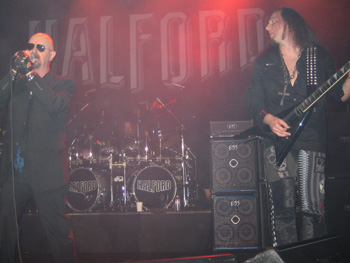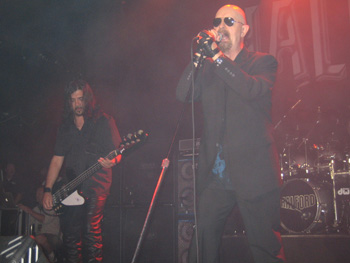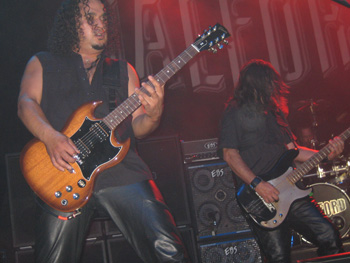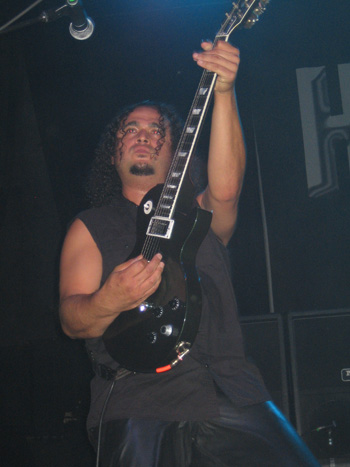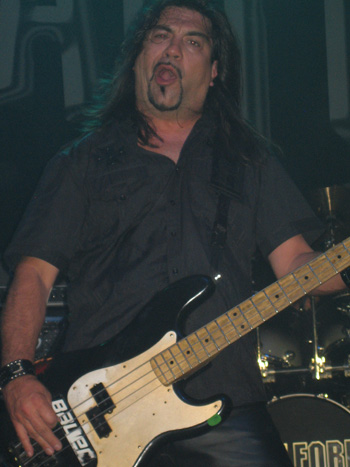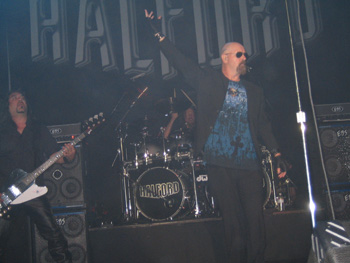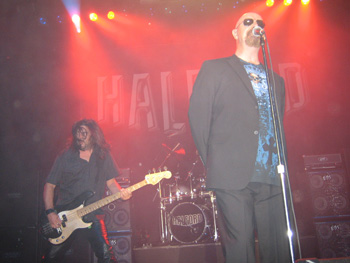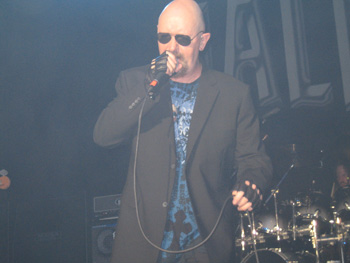| Before discussing the show specifics I should state, without a shred of doubt, Rod Stewart (“RS”) dispelled any doubts pessimistic naysayers held as to his ability, physical or mental, to perform. RS not only performed, he owned Oakland Arena (“OA”) and the throng of loyal fans in the nearly sold out venue. RS was clearly enjoying himself and his positive state of mind was infectious, the audience feeding off his energy and aura. RS’s dance moves were as fluid as maple syrup, distinctive voice as raspy as sandpaper, stage presence as graceful and natural as Chinese bark silk, and wardrobe as fashionable as a Fabergé egg. RS’s aging portrait is tucked away in his attic far away from public contact. Now on to the show. On April 20, 2011 RS played at Oakland’s 19,600?seat capacity OA (approximations presumed throughout). RS played a 20?song, 93?minute set from 9:15 to 10:48. An enormous curtain covered the entire length of the stage left to right, reached OA’s ceiling, and featured the “Rod Stewart” logo in fluorescent green atop a caricature of a train with RS as engineer engulfed in swirling, violet, purple, and fuchsia smoke clouds.
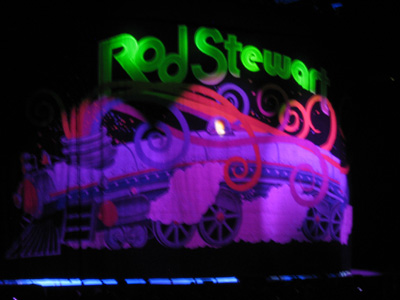
1. Love Train (The O’Jays cover: Back Stabbers record, 1972). As Love Train began the curtain raised revealing a large expansive, streamlined stage devoid of clutter (e.g., amplifiers). A large part of the stage rear was occupied by a three?step platform with the step covers comprised of plexiglass that illuminated various colors. Flanking each side of David Palmer’s drum set were four pillars atop which were mechanically?controlled strobe lights with 360?degree rotating abilities. The pillars extended to the outer portions of the stage, stage left and right. One color video screen stretched to the ends of the stage and displayed varying images during songs with crisp clarity. The video screen featured picture within picture, the smaller vertical?shaped video screen was half the size of the drum riser and displayed close?up images, primarily of RS. Love Train got the show off to an energetic start. After a 65?second musical introduction during which the video screen displayed a cartoon of RS’s train billowing from stage left to right RS came on stage. The video screen then displayed swirling neon?colored images while the drum riser and pillars flashed varying colors throughout the song.
RS’s band was comprised of 13 accomplished musicians: J’Anna Jacoby (“Jacoby,” mandolinist/fiddler), Charles Kentis (“Kentis,” keyboardist), Anne King (“King,” trumpeter), Donald Kirkpatrick (“Kirkpatrick,” guitarist), Conrad Korsch (“Korsch,” bassist), Matt O’Connor (“O’Connor,” percussionist), David Palmer (“Palmer,” drummer), Katja Rieckermann (“Rieckermann,” saxophonist), Jimmy Roberts (“Roberts,” saxophonist), Paul Warren (“Warren,” guitarist), as well as three back up singers, Kimberly Johnson, Di Reed, and Bridget Mohammed (“back up singers” collectively). The horn section and Jacoby primarily stood stage right and the back up singers stage left. The string instrument players, excluding Jacoby, stood atop the second platform step during most of the show while Kentis, Palmer, and O’Connor had their instruments positioned atop the third platform step. O’Connor played a pearl white percussion set that included two conga drums, two bongos, a tambourine, and cymbal. Palmer played a pearl white drum kit, single bass drum, and drum head that featured the green logo of “The Celtic Football Club 1888” against a white background. Palmer’s drum kit was housed within a clear plexiglass cage to minimize sound distribution. The plexiglass was not the traditional flat piece set at a 90 degree angle against the drum riser but rather six concave?shaped vertical panels connected by metal slots.
RS wore a gold satin blazer, long?sleeve button?down white cotton shirt (collar unbuttoned and untucked with short even hemline), thin black tie, black wool slacks, and shiny black leather half?boots. The male members of RS’s band initially wore black wool blazers, long?sleeve button?down white cotton shirts (collars buttoned), thin black ties, black wool slacks, and black leather shoes. The female members initially wore one?piece, thigh?length, tiered, ruffled red dresses and eventually switched to one?piece thigh?length, tiered, ruffled black dresses with thigh?level fringes.
At the start of Love Train King, Rieckermann, and Roberts stood stage right and the back up singers stage left. Kentis, Palmer, O’Connor, and Jacoby were positioned atop the third platform step. Jacoby was dancing in lieu of playing her violin or fiddle. Kirkpatrick, Warren, and Korsch were positioned on the second platform step.
Love Train is a mid tempo song that began with RS and the back up singers singing the first chorus with Palmer’s steady and catchy drum beat motivating the audience members to clap their hands and tap their feet, “People all over the world join hands. Start a love train, love train. People all over the world join hands. Start a love train, love train.” RS transitioned without pause to the first verse. RS then repeated the pattern from the first chorus and verse when he sang the second chorus and verse and transitioned without pause to the third chorus. A five?second musical interlude separated the third chorus and first bridge after which RS sang the bridge by twice shouting, “Let it ride!” Roberts then performed a 15?second saxophone (“sax”) solo immediately followed by Warren’s 15?second guitar solo. RS and the back up singers then sang the third chorus.
2. Tonight’s the Night (Gonna Be Alright) (A Night on the Town, 1976) is a beautiful slow tempo ballad that began with RS singing the first two verses separated by a five?second musical interlude, “Stay away from my window. Stay away from my back door too. Disconnect the telephone line. Relax baby and draw that blind. (verse transition) Kick off your shoes and sit right down. Loosen off that pretty French gown. Let me pour you a good long drink. Ooh baby don’t you hesitate ‘cause . . .” [RS’s lyrics are interesting, painting the picture of someone who is a cross between a romantic and jealous lover who falsely imprisons his girlfriend.] The verses prominently featured Kentis’ keyboards. Roberts and Jacoby played sax and violin, respectively, stage right. The video screen displayed a large image of a blue moon accented with the platform and pillars illuminated light blue.
RS transitioned without pause from the second verse to the first chorus while the platform and pillars changed to violet illumination, “Tonight’s the night. It’s gonna be alright. ‘Cause I love you girl. Ain’t nobody gonna stop us now.” The audience was very audible during the chorus. After a five?second musical interlude that followed the first chorus RS sang the third verse after which he transitioned without pause to the second chorus. Rieckermann then came center stage up front and played a 25?second sax solo during which the platform and pillars switched back to light blue illumination. RS then repeated the pattern from the third verse and second chorus when he sang the fourth verse and third chorus.
3. Havin’ A Party (Sam Cooke cover: single release, 1962) is an up tempo song that began with RS shouting, “Yeah, clap your hands!” after which he sang the first verse that reflected the song’s positive party vibe, “We’re having a party. Dancing to the music … played by the D.J. … on the radio. The Cokes are in the ice box. Popcorn’s on the table. Me and my baby, yeah … we’re out here on the floor, oh yeah!” RS transitioned without pause to the first chorus. Rieckermann, Roberts, and King played sax and trumpet, respectively, stage right. The video screen displayed multiple rows of vertically scrolling black, white, red, and green graphics (i.e., circle within a circle within a square within a square). The graphics were reminiscent of the 1960’s. The platform and pillars were illuminated gold.
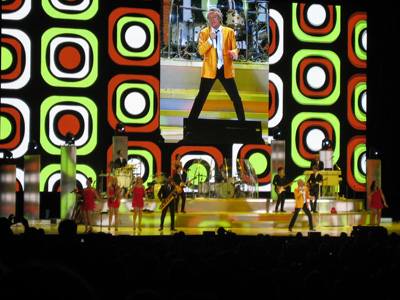
RS then repeated the pattern from the first verse and chorus when he sang the second verse and chorus. Rieckermann played a 20?second sax solo during which the platform and pillars switched between violet and light blue illumination. Rieckermann’s solo was immediately followed by King’s 30?second trumpet solo. King’s solo transitioned without pause into the third chorus followed immediately by the third and final verse with light-hearted lyrics, “Having a party. Everybody’s swinging. Dancing to the music … on the radio … yeah … we’re having a party. Everybody’s swinging. Dancing to the music … yeah … on the radio.” [The lyrics are a testament to how simple yet catchy lyrics can be enjoyable. It is analogous to eating Jello?O, a fun, simple desert.]
4. Young Turks (with Stevie Nicks) (Tonight I’m Yours, 1981). Before Young Turks RS said, “Once again my friend and your friend will come out. Steve Nicks!” Stevie Nicks (“SN”) came on stage in a one?piece black thigh?length dress with forearm?length, oversized, semi?ruffled sleeves, black pantyhose, and black lace gloves. Young Turks is an up tempo song that featured the back up singers stage left. RS sang the first verse of this biographical tale of two young lovers, “Billy left his home with a dollar in his pocket and a head full of dreams. He said somehow, some way, it’s gotta get better than this. Patty packed her bags, left a note for her momma. She was just seventeen, there were tears in her eyes when she kissed her little sister goodbye.”
After a brief two?second musical interlude SN sang the second verse, “They held each other tight as they drove on through the night. They were so excited. We got just one shot of life, let’s take it while we’re still not afraid. Because life is so brief and time is a thief when you’re undecided. And like a fistful of sand, it can slip right through your hands.” The tempo slightly slowed down but maintained an up tempo pace after which RS and SN co?sang the first chorus that prominently featured Kentis’ atmospheric keyboard chords. The tempo then resumed its initial pace and after a 10?second musical interlude following the first chorus, RS sang the third verse. RS and SN then co?sang the second chorus.
A 10?second musical interlude separated the second chorus from Warren’s 20?second guitar solo on his burgundy Fender Stratocaster with silver speckles during which the back up singers moved stage front center and flanked SN. SN and the back up singers co?sang an instrumental verse comprised of “woohs” that replicated the verse melody. SN and RS then split up the fourth verse with SN and RS singing the first and final two lines, respectively. SN and RS then co?sang the third and final chorus. The video screen displayed flames while the platform and pillars were illuminated yellow.
5. Leather and Lace (with Stevie Nicks) (Bella Donna, 1981). Before Leather and Lace SN’s lead guitarist, Waddy Wachtel (“Wachtel”), came on stage, which prompted RS to say, “This man has played on some of my albums in the 70’s. (audience cheered) This is Stevie’s song.” Leather and Lace is a ballad that prominently featured Wachtel’s acoustic guitars and Kentis’ keyboards. [Kentis’ keyboard notes sounded like the type one hears when opening a music box or when listening to Richard Wright’s (late Pink Floyd keyboardist) innovative keyboard playing while tripping on acid.] Wachtel played a maple acoustic guitar stage left next to the back up singers. After a 15?second musical introduction SN sang the first verse standing next to RS. SN transitioned without pause to the first chorus, which RS co-sang.
SN and RS then repeated the pattern from the first verse and chorus, the differences being (1) RS sang the second verse in lieu of SN and (2) RS and SN twice repeated the second chorus. The song did not feature a guitar solo. The video screen displayed a black background depicting a night sky sprinkled with bright shimmering stars adorned with undulating flower stems that gradually changed from blue to white. [The stars reminded me of those I saw at a Black Sabbath concert after I bonked my headbanging head on a blunt object.] The platform and pillars were illuminated light blue.
6. Forever Young (Bob Dylan cover: Planet Waves, 1974, Out of Order, 1988). Before Forever Young the video screen displayed three identical photographs (“photos”) of RS’s adorable, youngest son, Aiden Stewart, wearing a green and white horizontal striped jumpsuit. RS took his blazer off, and while rolling his shirt sleeves up to his elbows, said, “This is my baby, eight weeks old today.” Forever Young is a mid tempo song featuring Korsch’s pulsating bass lines. The audience clapped in unison to the song’s catchy beat. After a 15?second musical introduction RS sang the first verse containing touching lyrics and emphasized the first word of odd verse lines, “May the good Lord be with you … down every road you roam … and may sunshine and happiness surround you … when you’re far from home … and may you grow to be proud … dignified and true … and do onto others as you’d have done to you.” A three?second musical interlude preceded the first chorus after which RS sang the first chorus with strong audience participation, particularly with the final two words, “Be courageous and be brave … and in my heart you’ll always stay forever young … forever young.” RS then sang second verse after which he transitioned without pause to the second chorus four times repeating the phrase, “Forever young.” RS quickly sang the phrase the first two times and slower the last two times emphasizing each syllable.
Kirkpatrick played a 15-second guitar solo on his natural wood Fender Telecaster center stage up front, and Jacoby played a tobacco sunburst acoustic guitar stage right. RS then repeated the pattern from the second verse and chorus when he sang the third verse and chorus, the difference being he six times repeated the phrase “Forever young” during the third chorus. During the third chorus RS turned his back to the audience and shook his buttocks, causing the female contingent to swoon. [Fortunately it was not my jiggling derriere, which would have registered on the Richter scale (manner of assigning a number to quantify the energy created during an earthquake).] Kirkpatrick and Warren then quickly scuttled down the riser and up front stage right and left, respectively where they played 10?second guitar solos with Warren playing his burgundy Fender Stratocaster after which the song’s tempo slowed down shortly before the song ended. The video screen displayed images of a cloudy blue sky accented with the platform and pillars illuminated white.
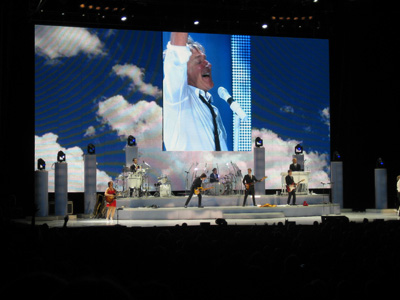
7. You Wear It Well (Never a Dull Moment, 1972). After a 30?second musical introduction that prominently featured Kentis’ flowing keyboard notes and Jacoby’s violin RS sang the four lines that comprise the first verse in quick succession and quickly transitioned to the first chorus, “You wear it well … a little old fashioned … but that’s all right.” RS then repeated the pattern from the first verse and chorus when he sang the second verse and chorus, the difference being the lyrics to the second chorus, “That you wear it well. There ain’t a lady in the land so fine.” RS then repeated the pattern from the second verse and chorus when he sang the third verse and chorus, the difference being the lyrics to the third chorus, “You wear it well. A little out of time, but I don’t mind.” [Being out of time in terms of coordination skills is the story of my life. I ran face first into a ceiling to floor mirror positioned stage left while moshing during Kiss’ unpublicized warm-up show at the now defunct The Stone club in San Francisco on April 23, 1992. Ace Frehley (“Frehley,” former Kiss lead guitarist) has the same dubious distinction. Frehley was so inebriated at his show at the now defunct Omni club in Oakland on April 7, 1990 he fell on me while I was photographing him in the pit. That night Frehley did not consume the magic elixir he customarily uses to counteract the effects of alcohol, a Filet?O?Fish McDonald’s sandwich. True story from Frehley himself!]
RS then sang the bridge after which Jacoby, who stood stage right, played a 20?second violin solo replicating the chorus melody during which RS tossed his white microphone (“mike”) stand up over his head. Warren played his burgundy Stratocaster and Kirkpatrick a natural wood acoustic guitar atop the platform’s second step. RS then repeated the pattern from the third verse and chorus when he sang the fourth verse, fourth chorus, and the bridge. Warren then played a 20?second guitar solo after which RS sang the final line, “‘Cos I ain’t forgetting that you were once mine.” Up through the bridge the video screen displayed a gold background accented with sporadic psychedelic, dark brown streaks. After the bridge the video screen, platform and pillars were illuminated red.
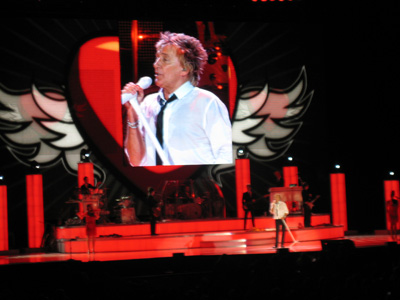
8. The First Cut is the Deepest (Cat Stevens cover: single release by P. P. Arnold, 1967, A Night on the Town, 1976). The first 30 seconds of The First Cut is the Deepest featured Kirkpatrick’s acoustic guitar chords accompanied by Kentis’ keyboard notes while the video screen displayed three identical caricatures of RS’s head. A straight razor then appeared on the video screen and cut a small gash on RS’s face, causing a drop of blood to fall into the underlying red heart that split in two and developed wings while the platform and pillars were illuminated red. [The last time I recall such vivid imagery depicting two of my favorite objects, blood and a sharp instrument, certainly not my brain, was the video screen imagery at Slayer’s concert at the San Jose Event Center during the God Hates Us All tour (08-03-02).] RS then sang the first verse of this ballad while the two hearts on the video screen were replaced by one larger winged heart positioned behind but extending beyond the picture within picture.
RS then sang the first chorus with strong audience participation, “The first cut is the deepest. Baby I know the first cut is the deepest. But when it comes to being lucky she’s cursed. When it comes to loving me she’s the worst.” During the 10?second musical interlude between the first chorus and second verse Kirkpatrick and Warren played descending arpeggio notes. RS then repeated the pattern from the first verse and chorus when he sang the second verse and chorus. Jacoby then played a 20?second violin solo immediately followed by Warren’s fiery 60?second guitar solo on his tobacco sunburst guitar. The platform and pillars were illuminated violet during the solos. RS then repeated the second verse and chorus.
9. Twistin’ the Night Away (Sam Cooke cover: single release, 1962, Never a Dull Moment, 1962). Before Twistin’ the Night Away RS asked, “Is it a good show so far?!” (audience applause) After a 10?second musical introduction that prominently featured Kentis’ up beat keyboard notes and King’s trumpet playing RS sang the first verse after which he transitioned without pause to the second verse followed by the first chorus. The first chorus prominently featured Rieckermann and Roberts’ sax playing while RS twice sang, “Twistin’, twistin’, twistin’ the night away.” Twistin’ the Night Away is a fun, up tempo song. RS then repeated the pattern from the first two verses and first chorus when he sang the third and fourth verses followed by the second chorus. Rieckermann, Roberts, and King played sax and trumpet, respectively, stage right while the back up singers were stage left.
Roberts then played a 40?second sax solo followed by Kentis’ 30?second keyboard solo on his white keyboard. RS then repeated the first verse after which he transitioned without pause to the first chorus. Kirkpatrick and Warren then came center stage up front where they engaged in a 60?second jam session that prominently featured Kentis’ keyboard prowess while RS shimmied (i.e., shook his shoulders and chest). [This daring feat would not have been safe for me to attempt without a man bra due to fear of striking those standing nearby with my man boobs.] RS then repeated the chorus a third and final time. The video screen displayed smaller and larger recurring caricatures of a dancing RS next to one another with a violet body and hot pink head and hands. [The color scheme screamed 1980’s. I reminisced about my Gumby green and plum parachute pants.] The platform and pillars switched between purple and fuchsia illumination.
10. This Old Heart of Mine (Is Weak for You) (Isley Brothers cover: single release, 1966, Atlantic Crossing, 1975). During the 20-second musical introduction to this up temp song the back up singers replicated the melody with “aahs.” RS then sang the first verse, “This old heart of mine been broke a thousand times. Each time you break away, feel you’re gone to stay. Lonely nights that come, memories that go, bringing you back again, hurting me more and more.” RS then transitioned without pause to the first chorus during which the back up singers provided accompaniment with “woohs” and that ended with RS twice singing the phrase, “I love you. This old heart weeps for you.” RS then repeated the pattern from the first verse and chorus when he sang the second verse and chorus.
Rieckermann, Roberts and King played sax and trumpet stage right while Jacoby stood atop the platform’s third step and played a tambourine and the back up singers were stage left. Roberts then played a 25?second sax solo during which the platform and pillars illuminated red and an audience member handed RS a beautiful bouquet of red roses. RS then repeated the second verse and chorus, the difference being that during the second chorus he four times repeated the phrase, “I love you. This old heart weeps for you.” The video screen displayed graphics of fuchsia and tan hearts and circles in chain link fashion while the platform and pillars illuminated purple.
11. Downtown Train (Tom Waits cover: Rain Dogs, 1985). Before Downtown Train RS said, “Just recently Tom Waits, a good friend of mine, was inducted into the Rock and Roll Hall of Fame. This is one of his songs.” Downtown Train began with a 15?second musical introduction featuring Kentis’ ethereal keyboard notes and Jacoby’s violin. RS then sang the first verse of this slow tempo ballad while sitting atop a white stool stage front center stage. Immediately after RS sang the last line of the first verse the song’s tempo momentarily escalated to a mid tempo pace, and RS then sang the first chorus. The tempo then resumed a slow tempo pace and RS repeated the pattern from the first verse and chorus when he sang the second verse and chorus. Rieckermann, Roberts, King, and Jacoby played sax, trumpet, and violin, respectively, stage right. Roberts was now wearing a red and black crosshatch pattern blazer.
After the second chorus RS and most of his band, except for Roberts, Palmer and O’Conner, left the stage. Roberts and Palmer engaged in a 45?second jam session followed by a 120?second jam session between Palmer and O’Connor with the latter taking position behind a three?piece drum set comprised of a bass drum, tom?tom, and snare drum on the platform’s third step. The video screen displayed lifelike images of the Brooklyn Bridge and a mid?rise apartment building stage right and left, respectively, that appeared three?dimensional. At the end of Downtown Train RS came on stage wearing a light metallic blue blazer and tie.
12. Reason to Believe (Tim Hardin cover: single release, 1965, Every Picture Tells A Story, 1971). Before Reason to Believe RS asked, “What is next? This song was recorded in 1969 as the B?side of Maggie May [single].” Reason to Believe began as a slow tempo ballad accented during the first verse by Jacoby’s violin playing and Kentis’ keyboards as RS sang, “If I listened long enough to you, I’d find a way to believe that it’s all true.” The slow tempo continued halfway through the first chorus. As RS began to sing the third line of the first chorus, the song’s tempo momentarily escalated to a mid tempo pace accented by Palmer’s drum beats and Korsch’s bass notes that he played on his standup (i.e., upright) bass. RS then sang the second verse and chorus still at a mid tempo pace with the second chorus containing sentimental lyrics, “Knowing that you lied, straight-faced, while I cried. Still I’d look to find a reason to believe. Someone like you makes it easy to live without somebody else. Someone like you makes it hard to give, never think about myself.”
Jacoby played a 15?second violin solo between the second and third lines of the second chorus. RS then repeated the second verse and chorus, the difference being that the tempo resumed a slow tempo pace when RS began to sing the chorus, “Still I look to find a reason to believe.” RS thrice repeated this phrase with the last time solely being accompanied by Kentis’ keyboards. Jacoby played violin stage right while Korsch, Kirkpatrick, and Warren played their instruments atop the platform’s second step. Palmer, Kentis, and O’Connor were now wearing red and black crosshatch pattern blazers. The video screen displayed images of flowers, initially blue and fuchsia and then purple and fuchsia while the platform and pillars switched between blue and purple illumination.
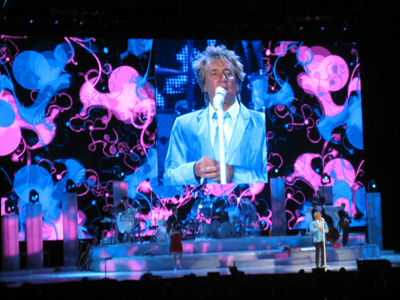
13. You’re In My Heart (The Final Acclaim) (Foot Loose & Fancy Free, 1977). Before You’re In My Heart (The Final Acclaim) RS said, “You will like this one!” and held a mixed floral bouquet at the start of the song. RS sang the first two verses accompanied by Kentis’ keyboards, Jacoby’s violin, and “woohs” of the back up singers who were now wearing one?piece black dresses stage right. RS transitioned without pause to the first chorus at which point the song’s tempo momentarily escalated to a mid tempo pace with Korsch’s bass lines particularly prominent. The catchy chorus prompted strong audience participation, “You’re in my heart, you’re in my soul. You’ll be my breath should I grow old. You are my lover, you’re my best friend. You’re in my soul.” The song’s tempo then resumed a slow tempo pace and RS sang the third verse only to then escalate to a mid tempo pace when RS began to sing the second chorus.
RS then repeated the pattern from the third verse and second chorus when he sang the fourth verse and third chorus. Kirkpatrick and Warren played acoustic guitars, natural wood and tobacco sunburst, respectively, and stood atop the platform’s second step. The video screen displayed a night sky with white and yellow stars while the platform and pillars were not illuminated until the end of the song when the video screen displayed three identical images of the green and white logo of “The Celtic Football Club 1888” while the platform and pillars were illuminated emerald green.
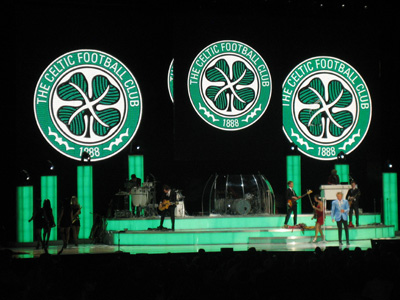
14. Sweet Little Rock ‘N’ Roller (Chuck Berry cover: single release, 1958, Smiler, 1974). Before Sweet Little Rock ‘N’ Roller RS, who had taken his blazer off, asked, “Is it hot in here? This is a simple song with three chords, and we are going to play all three chords.” Sweet Little Rock ‘N’ Roller is an up tempo song with a very catchy chord progression. RS sang the first verse during which Korsch’s bass lines and Kentis’ keyboards were particularly prominent, with the latter being reminiscent of Jerry Lee Lewis’ (American rock and roll singer, pianist) playing style, “She’s nine years old and sweet as she can be. All dressed up like a downtown Christmas tree. Dancin’ and hummin’ a rock-roll melody. She’s the daughter of a well-respected man. Who taught her how to judge and understand. Since she became a rock-roll music fan.” The lyrics typify Chuck Berry’s simplistic yet effective writing style. [Aspiring artists who feel compelled to emulate Emerson, Lake & Palmer (English progressive rock band) to demonstrate their songwriting prowess should instead listen to Chuck Berry.] RS transitioned without pause from the first verse to the first chorus. RS then repeated the pattern from the first verse and chorus when he sang the second verse and chorus.
Roberts, Rieckermann, and King played trumpet and sax, respectively, stage right with the latter two now wearing one?piece black dresses. Kirkpatrick, Warren, and Kosch played their instruments stage front with Kosch stage right and Warren and Kirkpatrick stage left. Warren then played a fiery 40?second guitar solo on his gold Les Paul while Kirkpatrick played rhythm guitar on his maple Gretsch and Kosch provided a solid foundation on his tobacco sunburst bass. Roberts then played a 40?second sax solo center stage up front while RS, Kirkpatrick, Warren, and Kosch stood next one another behind Roberts. The song’s tempo then momentarily slowed to a mid tempo pace. Kirkpatrick, Warren, and Kosch stood stage left where they were joined by the back up singers while RS thrice repeated the phrase, “I said dance, dance little sister, dance.” The song’s tempo then resumed an up tempo pace and RS sang the third and final chorus. The video screen displayed red and black crosshatch patterns atop which appeared recurring silhouettes of a guitarist with a white border. Sweet Little Rock ‘N’ Roller and four others songs to be performed received the strongest audience reaction.
15. Rhythm of My Heart (Vagabond Heart, 1991). Before Rhythm of My Heart RS introduced his band members. [Given the quantity of band members, I thought RS was going to pull out a Bible?sized notebook to refresh his memory while we undergo a seasonal change in the process.] RS then said, “I want to dedicate this to the servicemen.” The first 15 seconds of this ballad featured Jacoby and Kentis playing the melody with violin and keyboards at a slow tempo pace. Warren and Kirkpatrick’s powerful guitar chords and Palmer’s solid drum beats then momentarily converted the song to a power ballad for 15 seconds. The song then resumed a slow tempo pace while RS sang the first verse. RS transitioned without pause to the first chorus at which point the song momentarily converted to a power ballad. The chorus’ lyrics are heartfelt, “Oh, rhythm of my heart … is beating like a drum … with the words, ‘I Love you’ … rolling off my tongue. No never will I roam … for I know my place is home. Where the ocean meets the sky … I’ll be sailing.” RS then repeated the pattern from the first verse and chorus when he sang the second verse and chorus.
Jacoby, who was now wearing a one?piece black dress, played violin stage right while the back up singers sang stage left. Kirkpatrick, Kosch, and Warren stood atop the platform’s second step and played a red Fender Stratocaster guitar, tobacco sunburst bass, and tobacco sunburst Fender Stratocaster guitar, respectively. Kirkpatrick then played a 10?second guitar solo after which RS repeated the pattern from the second verse and chorus when he sang the third verse and chorus. The back up singers then joined RS up front center stage for the fourth and final chorus, which they sang solely accompanied by Kentis’ keyboards. RS sang the first two chorus lines after which Bridget Mohammed (“Mohammed”) repeated the chorus phrase, “Beats like a drum.” RS then sang the third and fourth chorus lines after which Kimberly Johnson (“Johnson”) repeated the two lines. RS then sang the fifth and sixth chorus lines after which Di Reed (“Reed”) sang, “He said it so beautiful. He knows his place is home.” RS then sang the final two chorus lines while the video screen displayed smoke against a black background. At the end of the song the video screen displayed an image of the American flag.
16. Knock on Wood (Eddie Floyd cover: single release, 1966). Before Knock on Wood RS said, “This is a great night so far … fantastic. I plan to turn back time. This is a big hit from the early 1980’s.” [I also have a tendency to turn back time; each time I pull something out of my outdated wardrobe.] RS left the stage and Reed sang Knock on Wood while Mohammed, Johnson, and Jacoby provided back up vocals. The first 15 seconds of this up beat song featured Palmer’s mid tempo drum beat while Mohammed, Johnson, and Jacoby clapped. During the next 15 seconds Rieckermann and Roberts played ascending sax chord progressions. Reed then sang the first verse and transitioned without pause to the first chorus that featured the signature sax chord progression accented by Mohammed, Johnson, and Jacoby chanting “woohs” that replicated the chorus melody. Reed then repeated the pattern from the first verse and chorus when she sang the second verse and chorus, the difference being that Mohammed, Johnson, and Jacoby four times repeated the chorus, “You better knock, knock on wood, baby!” [I was surprised no one tried to tap my hollow head.]
Kentis then played a 10?second keyboard solo. Rieckermann, Roberts, and King played sax and trumpet, respectively, stage right while Kirkpatrick and Warren played their natural wood Fender Telecaster and gold Les Paul guitars, respectively, on the platform’s second step. Reed then repeated the pattern from the second verse and chorus when she sang the third verse and chorus, the difference being that Mohammed, Johnson, and Jacoby eight times repeated the chorus. The video screen displayed varying colorful images, including swirling pastel?colored graphics and golden beams of light that emanated from the region behind the picture within picture. Knock on Wood, Sweet Little Rock ‘N’ Roller, and three others songs to be performed received the strongest audience reaction.
17. Have I Told You Lately (Van Morrison cover: Avalon Sunset, 1989, Vagabond Heart, 1991). Before Have I Told You Lately RS said, “What do you think of my suit?!” RS was referring to his elegant purple suit (i.e., blazer and slacks) along with a button?down light violet cotton shirt (collar unbuttoned, sans tie). [Rock star was the only phrase that came to my mind. Note to self: retire my Members Only tan jacket and aqua blue Esprit sweater circa 1981.] After a 10?second musical introduction to this sentimental ballad that featured Kentis’ touching keyboard notes RS sang the first chorus with great emotion while clutching his white mike mounted in a white stand, “Have I told you lately that I love you. Have I told you there’s no one else above you. Fill my heart with gladness. Take away all my sadness. Ease my troubles that’s what you do.” RS transitioned without pause to the first verse.
Jacoby, who was positioned stage right, then played a 30?second violin solo followed by a 30?second Kirkpatrick guitar solo on his natural wood sunburst acoustic guitar. The back up singers were positioned stage left. RS then sang the second verse and chorus. RS ended the song by seven times repeating the phrase, “You ease my troubles” with a guitar chord accent provided by Kirkpatrick and Warren after each recitation of the phrase reminiscent of James Brown (Black American singer known as the “Godfather of Soul”). The video screen displayed a black background depicting a night sky sprinkled with faint stars while the platform and pillars were illuminated light blue.
After the song ended RS directed the audience’s attention to the video screen that displayed a 15?second video clip of a tan dog sleeping on his side startled awake, likely due to a loud sound. The video screen then displayed two humorous RS photos dressed in drag outfits. The first photo featured RS in a skimpy, white nurse uniform complete with black biker’s cap. The second photo featured RS in black pantyhose, black lingerie slip, black feather boa, pearl necklace, and blonde wig.
18. Hot Legs (Foot Loose & Fancy Free, 1977) is a catchy mid tempo song that began with a 40?second musical introduction that featured Palmer’s solid drum beat during which Kirkpatrick and Warren were stage front center stage playing bluesy guitar notes. After this introduction RS sang the racy lyrics to the first verse, “Who’s that knocking on my door. It’s gotta be a quarter to four. Is it you again coming ‘round for more? Well you can love me tonight if you want. But in the morning make sure you’re gone. I’m talkin’ to you!” [The lyrics are reflective more of Mr. Carnal than Mr. Romance.] The house lights were on during the entire song while RS kicked and tossed multiple black and white soccer balls into the audience. Stagehands positioned in the pit stage left and right tossed the balls to RS. RS then sang the first chorus with plenty of audience participation and emphasized the first two words of each line, “Hot legs, wearing me out. Hot legs, you can scream and shout. Hot legs, are you still in school. I love you honey!” RS then repeated the pattern from the first verse and chorus when he sang second verse and chorus.
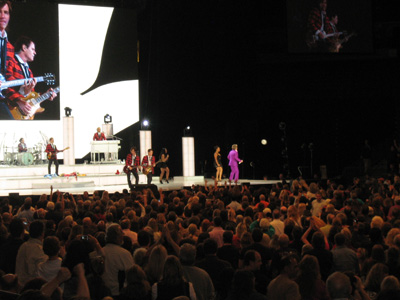
Rieckermann and Roberts played sax stage right, the back up singers sang stage left, Korsch played bass on the platform’s second step in front of Palmer’s drum kit while O’Connor played the second drum kit and Jacoby stood next to O’Connor playing maracas. The band then engaged in a 40?second jam session that included Korsch’s thumping bass lines and Kirkpatrick and Warren’s bluesy guitar notes. RS then sang the third through sixth choruses after which he four times screamed the final chorus line, “I love you honey!” I have no recollection what the video screen displayed. [My infinitesimal brain was busily distracted following the pretty, bouncing balls.] Hot Legs, along with Knock on Wood, Sweet Little Rock ‘N’ Roller, and two others songs to be performed received the strongest audience reaction with Hot Legs the strongest.
19. Maggie May (Every Picture Tells a Story, 1971). Before Maggie May RS said, “I’ve got one more to do.” The first 10 seconds of Maggie May featured Jacoby playing mandolin while Kirkpatrick and Warren played their natural wood acoustic and burgundy Fender Stratocaster guitars, respectively, stage front center stage next to RS. At the 0:10 mark Korsch, who was also standing next to RS, began playing low bass lines on his tobacco sunburst bass and was joined at the 0:15 mark by Palmer who began playing a simple drum beat. At the 0:20 mark the audience, with little need for motivation from RS, loudly sang the first verse, “Wake up Maggie, I think I got something to say to you. It’s late September and I really should be back at school. I know I keep you amused but I feel I’m being used.” RS, who stopped singing early in the verse, resumed singing during the final verse line and then transitioned without pause to the first chorus accented by Kentis’ soft keyboard notes, “Oh Maggie, I couldn’t have tried any more. You led me away from home just to save you from being alone. You stole my heart and that’s what really hurt.” RS then repeated the pattern from the first verse and chorus when he sang the second verse and chorus followed by the third verse and chorus.
Warren then played a 15?second guitar solo immediately followed by RS singing the fourth verse. RS then sang the fourth chorus acapella with strong audience participation, “Oh Maggie, I wish that I’d never seen your face. You made a first-class fool out of me. But I’m as blind as a fool can be. You stole my heart but I love you anyway.” The band then stopped playing for one second and then resumed with the band engaging in a 25?second jam session. The platforms and pillars switched between yellow and blue illumination and the spot lights went off while the band continued to jam with the emphasis on Jacoby and Korsch’s mandolin and bass playing, respectively. RS then twice sang the final two lines, “Maggie, I wish I’d never seen your face. I’ll get on back home one of these days.” The band then engaged in a 10?second jam session during which the enormous curtain that initially covered the stage came back down before Palmer’s final drum beats. Maggie May, along with Hot Legs, Knock on Wood , Sweet Little Rock ‘N’ Roller, and another song to be performed received the strongest audience reaction. RS and his band left the stage at 10:43 and returned in one minute to play one additional song.
20. Da Ya Think I’m Sexy? (Blondes Have More Fun, 1978). Before Da Ya Think I’m Sexy? RS said, “Thank you for coming out tonight and spending your hard?earned dollars.” [Thank you to RS’s management for generously providing complimentary tickets.] Da Ya Think I’m Sexy? is one of RS’s biggest hits with an up tempo, funky beat. The first 20 seconds featured Kirkpatrick’s punchy bass lines and Palmer’s up tempo drum beats. At the 0:35 mark RS and the back up singers who were positioned stage left began to replicate the song’s catchy melody for 15 seconds with “woohs.” RS then sang the first verse in a particularly sultry voice, “She sits alone waiting for suggestions. He’s so nervous avoiding all the questions. His lips are dry, her heart is gently pounding. Don’t you just know exactly what they’re thinking.” RS then transitioned without pause to the first chorus that featured a very catchy melody, “If you want my body and you think I’m sexy … come on sugar let me know. If you really need me just reach out and touch me … come on honey tell me so. Tell me so baby.”
During the 25?second musical interlude between the first chorus and second verse the back up singers once again replicated the song’s catchy melody with “woohs” while RS danced wearing a red and black crosshatched pattern biker’s cap. RS then repeated the pattern from the first verse and chorus when he sang the second verse and chorus. Rieckermann, Roberts, King and Jacoby played sax, trumpet, and violin, respectively, stage right. The back up singers then once again replicated the catchy melody with “woohs” after which RS sang the bridge, “His heart’s beating like a drum … ‘cos at last he’s got this girl home. Relax baby now we are alone.” Rieckermann then played a 30?second sax solo. The video screen displayed images of two disco balls and the platform and pillars illuminated red. RS then repeated the pattern from the second verse and chorus when he sang the third verse and chorus, which was followed by the fourth and final chorus after which the curtain came back down. Da Ya Think I’m Sexy?, along with Maggie May, Hot Legs, Knock on Wood and Sweet Little Rock ‘N’ Roller received the strongest audience reaction.
Venue: OA is an indoor arena constructed in 1966. OA is located in Oakland’s industrial district. In 1996 OA underwent a $121,000,000 renovation that lasted one year during which much of the interior was torn down, including seating. Artists such as AC/DC, Kiss, Judas Priest, The Grateful Dead, Slayer, Slipknot, Sepultura, Madonna, and Creedence Clearwater Revival have performed at OA.
Opening Band: Stevie Nicks.
Arash Moussavian, Entertainment Law Attorney
arashmoussavian@cal.berkeley.edu
www.linkedin.com/in/arashmoussavian
All photos taken by Arash Moussavian. This article and all photos are protected by copyright. Please contact me prior to use, or I will make shish kabab of your loins. |








